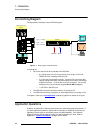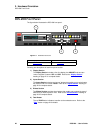
DCS-200 • User’s Guide 17
NK==fåíêçÇìÅíáçå
About the DCS-200
^=tçêÇ=^Äçìí=ea`m
HDCP stands for High-Bandwidth Digital Content Protection, an industry-wide copy
protection scheme that is used to prevent the potential interception of digital data between
the source (e.g., a Blu-Ray player) and the target display (e.g., an HDCP compliant display
or monitor). The HDCP format was designed by Intel
®
, and it uses an “authentication and
key exchange” procedure to accomplish the required protection. For proper
implementation, products that are compatible with the HDCP format require a secure
connection to a compliant display, such as a projector or monitor.
In applications in which a DCS-200 is used, when an HDCP compliant device is connected
to the DCS-200, an HDCP “session” is created. In this session (which is transparent to the
user), “keys” are exchanged between the source device (e.g., a Blu-Ray player) and the
HDCP compliant display.
The source device queries the display to ensure that the equipment is HDCP compliant
before video is shown. Non-HDCP equipment such as PCs will work with any DVI
compliant display, but HDCP compliant equipment only shows “protected” content on
HDCP compliant displays.
Please note the following important points:
• When an HDCP compliant device is connected to the DCS-200 and that specific
input is selected, the Status Menu indicates if HDCP is enabled.
• If the “session” determines that the target display device is non-HDCP compliant
(e.g., if the user is attempting to make an illegal copy on an external recorder), an
error message appears on the DCS-200’s Status Menu, indicating that video
cannot be shown.
• HDCP compliant repeaters cannot be connected to the output of the DCS-200, as
the DCS-200 must be the last device in the HDCP "chain" — prior to the HDCP
compliant display. If an HDCP repeater is connected, the message “HDCP
Violation” appears on the Status Menu. In Chapter 4, refer to the “Status Menu
”
section on page 44 for additional details.


















